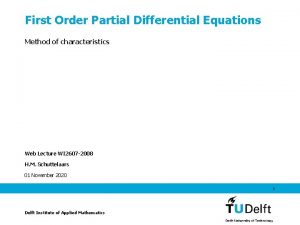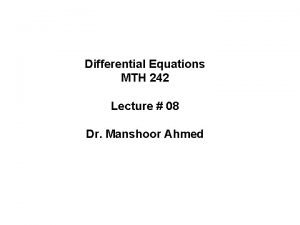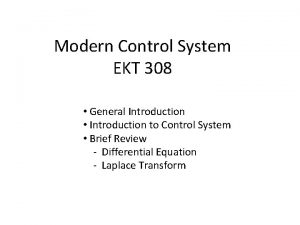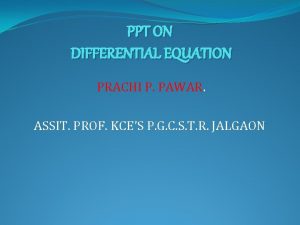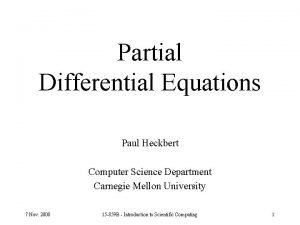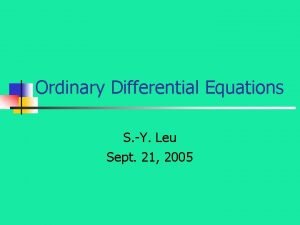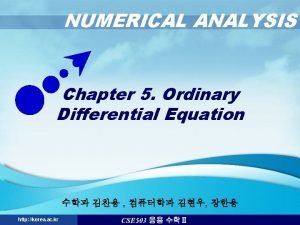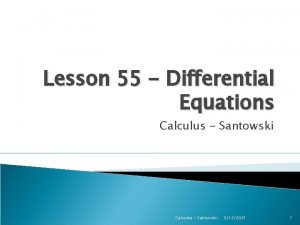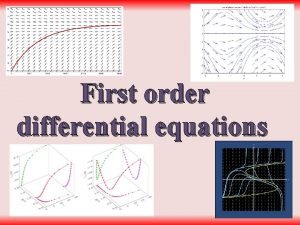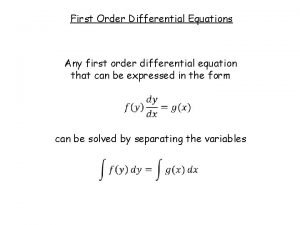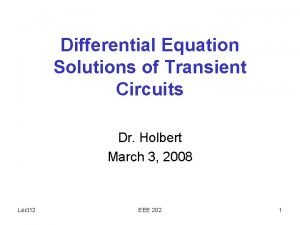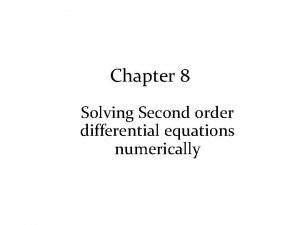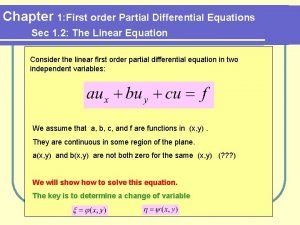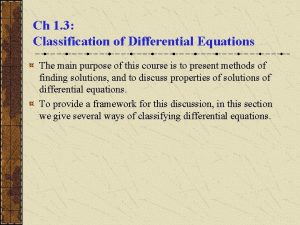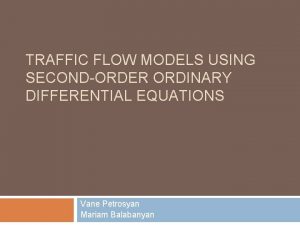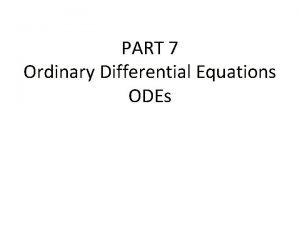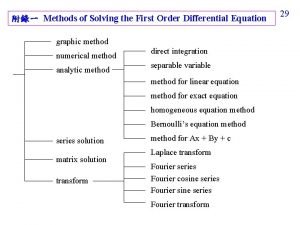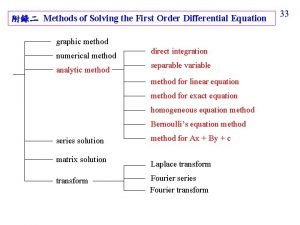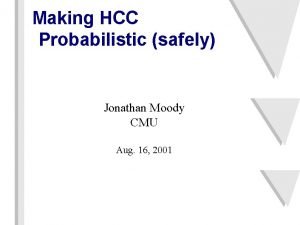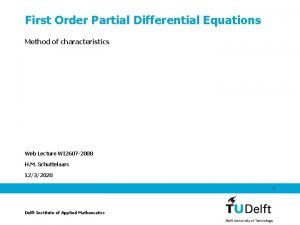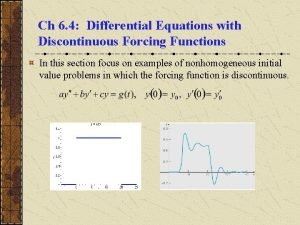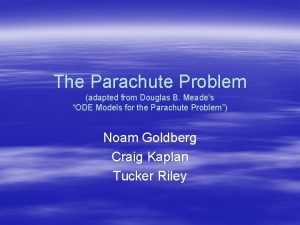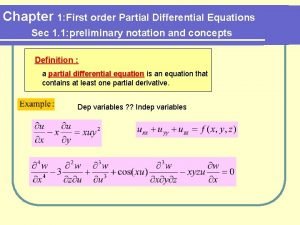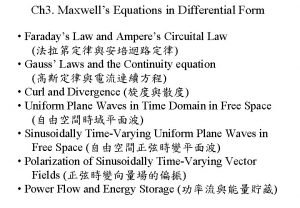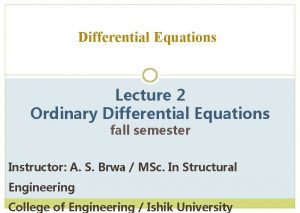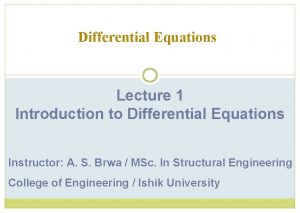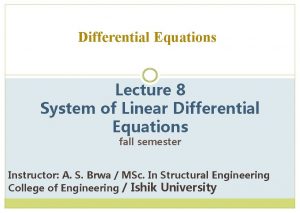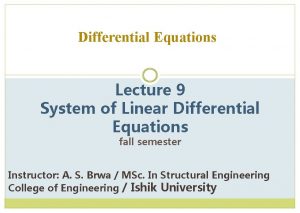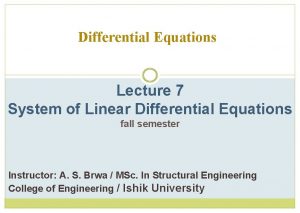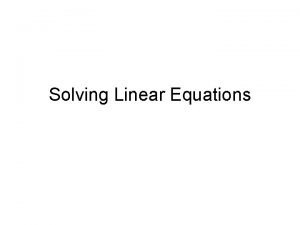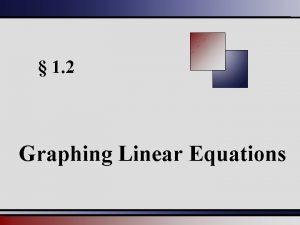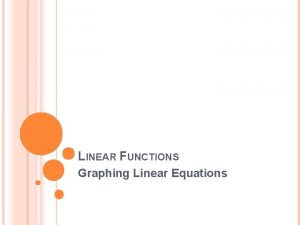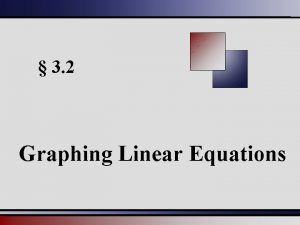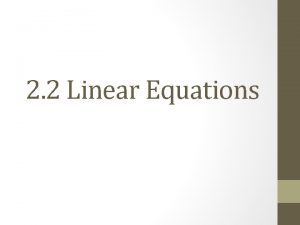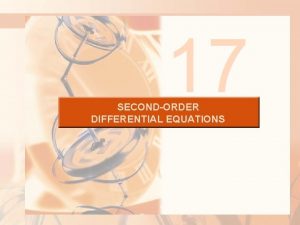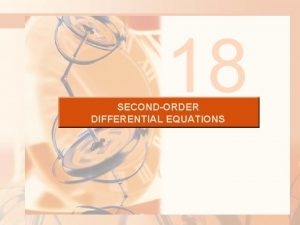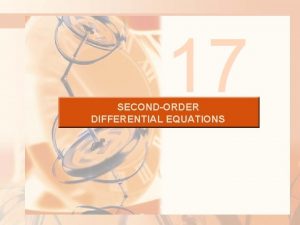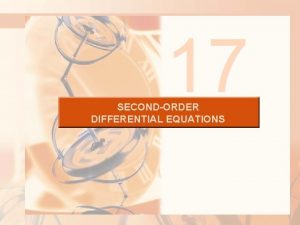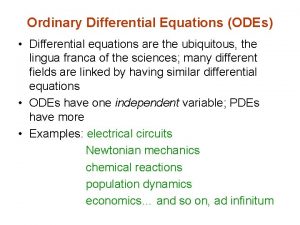Lecture 28 Linear Differential Equations Last Lecture Summary








































- Slides: 40

Lecture 28 Linear Differential Equations

Last Lecture Summary Last time, we covered the topic: Separable Differential Equations • Separable Equations • Method of Solution

Today We will cover the topic: • Linear Differential Equations • Applications of Differential Equation – Mathematical Modeling

Linear Equations An equation of the form is called a (1 st Order) Linear Differential Equation. 1 st Order – because the highest derivative appearing in the equation is of order 1.

The equation can be rewritten in the following famous form where and are continuous functions.

6

Method of solution The general solution of the first order linear differential equation is given by The function is called the integrating factor. If there is an IC given, then we use it to find the constant C. 7

Summary: 1. Identify that the equation is 1 st order linear equation. Rewrite it in the form if the equation is not already in this form. 2. Find the integrating factor

3. Write down the general solution 4. If you are given an IVP, use the initial condition to find the constant C. 5. Plug in the calculated value to write the particular solution of the problem.

Example Solve Solution: This is already in the standard form Where and

Now the integrating factor is Multiplying with the , we get



Example Solve 14





Modeling with Differential Equations By the term mathematical modeling we mean the process whereby the behavior of a real – life system or phenomenon, whether physical, sociological, or even economics is described by a set of mathematical relations, after approximation and idealizations. Construction of mathematical model starts with

1. Identification of the system for modeling. This requires selection of some variables as important to understanding or describing the behavior of the system and ignoring other as marginal or irrelevant to this understanding. 2. Making some realistic assumption, or hypothesis, about the system we are describing. These assumptions will also include any empirical laws that may be applicable of the system.

3. Modeling steps are the steps that lead from the physical situation to a mathematical formulation and solution, then physical interpretation of the result. Now, let’s solve some models that are described by linear first order differential equations.

Growth and Decay : •

Step 2: Solving the differential equation obtained ………………. . (1) Integrating (1), we obtain

…………………(2) K > 0, for growth K < 0, for decay C is an arbitrary constant and can be determined by using initial condition and value of k changes from problem to problem. Step 3: Interpretation of the result.

Example (Bacterial Growth) Solution: We first solve the differential equation …………………. . (1)

Subject to . Then we use the empirical condition to determine the constant of proportionality k. Now Eq. (1) is both separable and linear. When it is put into the form ……. . . (2) We can see by inspection that the integrating factor is . Multiplying (2) with , we get ………………. (3) Integrating (3) ………………. (4)


It follows from , that so equation (4) takes the form at , we have ………………. (5)

Thus To find the time at which the bacteria have tripled we solve



Example (Cooling of a Cake) When a cake is removed from an oven, its temperature is measured at 300 o. F. Three minutes later its temperature is 200 o. F. How long will it take for the cake to cool off to a room temperature of 70 o. F? Solution:








Review We covered the topic: • Linear Differential Equations • Applications of Differential Equations – Mathematical Modelig Next time, we will start Chapter 20: Functions of Several Variables 40
 First order pde method of characteristics
First order pde method of characteristics Partial differential equations formula
Partial differential equations formula Symplectic
Symplectic Higher order linear differential equations
Higher order linear differential equations Differential equations summary
Differential equations summary Randy pausch last lecture summary
Randy pausch last lecture summary Quadratic simultaneous equations
Quadratic simultaneous equations Difference between linear and nonlinear equations
Difference between linear and nonlinear equations Metode numerik sistem persamaan linear
Metode numerik sistem persamaan linear Differential equations projects
Differential equations projects Partial differential equations ppt
Partial differential equations ppt Differential equations in computer science
Differential equations in computer science Cengage differential equations
Cengage differential equations Linear differential equation
Linear differential equation Kutta
Kutta Define differential equation
Define differential equation Differential equations examples
Differential equations examples Integrating factor of differential equation
Integrating factor of differential equation Solving 1st order differential equations
Solving 1st order differential equations First order odes
First order odes Separation of variables differential equations
Separation of variables differential equations Transient solution differential equations
Transient solution differential equations Runge kutta second order formula
Runge kutta second order formula What is a first order equation
What is a first order equation Classifying differential equations
Classifying differential equations Traffic flow differential equations
Traffic flow differential equations Midpoint method formula
Midpoint method formula Modified euler formula
Modified euler formula First order linear differential equation
First order linear differential equation First order differential equation
First order differential equation Slidetodoc.com
Slidetodoc.com Differential equations
Differential equations Differential equations with discontinuous forcing functions
Differential equations with discontinuous forcing functions Bernoulli differential equation examples
Bernoulli differential equation examples Parachute problem differential equations
Parachute problem differential equations Non homogeneous differential equation
Non homogeneous differential equation Growth and decay differential equation
Growth and decay differential equation Differential equations zill solutions
Differential equations zill solutions Stewart differential equations
Stewart differential equations Differential equations chapter 1
Differential equations chapter 1 Hertz
Hertz
